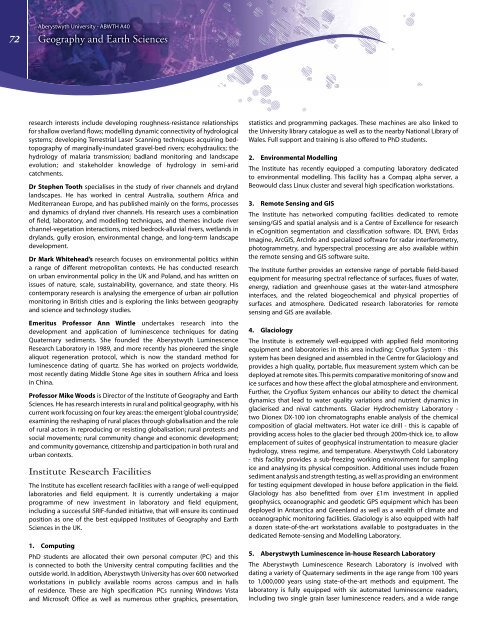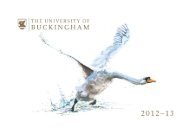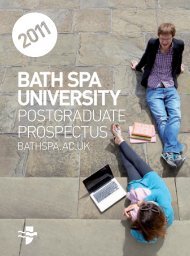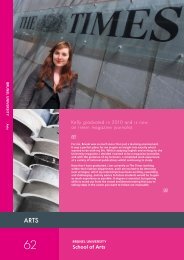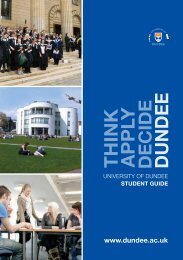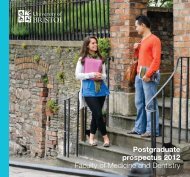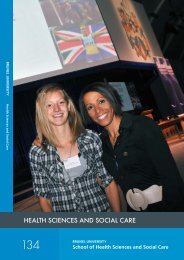Postgraduate Prospectus 2011
Postgraduate Prospectus 2011
Postgraduate Prospectus 2011
- No tags were found...
Create successful ePaper yourself
Turn your PDF publications into a flip-book with our unique Google optimized e-Paper software.
Aberystwyth University - ABWTH A4072 Geography and Earth Sciencesresearch interests include developing roughness-resistance relationshipsfor shallow overland flows; modelling dynamic connectivity of hydrologicalsystems; developing Terrestrial Laser Scanning techniques acquiring bedtopographyof marginally-inundated gravel-bed rivers; ecohydraulics; thehydrology of malaria transmission; badland monitoring and landscapeevolution; and stakeholder knowledge of hydrology in semi-aridcatchments.Dr Stephen Tooth specialises in the study of river channels and drylandlandscapes. He has worked in central Australia, southern Africa andMediterranean Europe, and has published mainly on the forms, processesand dynamics of dryland river channels. His research uses a combinationof field, laboratory, and modelling techniques, and themes include riverchannel-vegetation interactions, mixed bedrock-alluvial rivers, wetlands indrylands, gully erosion, environmental change, and long-term landscapedevelopment.Dr Mark Whitehead’s research focuses on environmental politics withina range of different metropolitan contexts. He has conducted researchon urban environmental policy in the UK and Poland, and has written onissues of nature, scale, sustainability, governance, and state theory. Hiscontemporary research is analysing the emergence of urban air pollutionmonitoring in British cities and is exploring the links between geographyand science and technology studies.Emeritus Professor Ann Wintle undertakes research into thedevelopment and application of luminescence techniques for datingQuaternary sediments. She founded the Aberystwyth LuminescenceResearch Laboratory in 1989, and more recently has pioneered the singlealiquot regeneration protocol, which is now the standard method forluminescence dating of quartz. She has worked on projects worldwide,most recently dating Middle Stone Age sites in southern Africa and loessin China.Professor Mike Woods is Director of the Institute of Geography and EarthSciences. He has research interests in rural and political geography, with hiscurrent work focussing on four key areas: the emergent ‘global countryside’,examining the reshaping of rural places through globalisation and the roleof rural actors in reproducing or resisting globalisation; rural protests andsocial movements; rural community change and economic development;and community governance, citizenship and participation in both rural andurban contexts.Institute Research FacilitiesThe Institute has excellent research facilities with a range of well-equippedlaboratories and field equipment. It is currently undertaking a majorprogramme of new investment in laboratory and field equipment,including a successful SRIF-funded initiative, that will ensure its continuedposition as one of the best equipped Institutes of Geography and EarthSciences in the UK.1. ComputingPhD students are allocated their own personal computer (PC) and thisis connected to both the University central computing facilities and theoutside world. In addition, Aberystwyth University has over 600 networkedworkstations in publicly available rooms across campus and in hallsof residence. These are high specification PCs running Windows Vistaand Microsoft Office as well as numerous other graphics, presentation,statistics and programming packages. These machines are also linked tothe University library catalogue as well as to the nearby National Library ofWales. Full support and training is also offered to PhD students.2. Environmental ModellingThe Institute has recently equipped a computing laboratory dedicatedto environmental modelling. This facility has a Compaq alpha server, aBeowould class Linux cluster and several high specification workstations.3. Remote Sensing and GISThe Institute has networked computing facilities dedicated to remotesensing/GIS and spatial analysis and is a Centre of Excellence for researchin eCognition segmentation and classification software. IDL ENVI, ErdasImagine, ArcGIS, ArcInfo and specialized software for radar interferometry,photogrammetry, and hyperspectral processing are also available withinthe remote sensing and GIS software suite.The Institute further provides an extensive range of portable field-basedequipment for measuring spectral reflectance of surfaces, fluxes of water,energy, radiation and greenhouse gases at the water-land atmosphereinterfaces, and the related biogeochemical and physical properties ofsurfaces and atmosphere. Dedicated research laboratories for remotesensing and GIS are available.4. GlaciologyThe Institute is extremely well-equipped with applied field monitoringequipment and laboratories in this area including: Cryoflux System - thissystem has been designed and assembled in the Centre for Glaciology andprovides a high quality, portable, flux measurement system which can bedeployed at remote sites. This permits comparative monitoring of snow andice surfaces and how these affect the global atmosphere and environment.Further, the Cryoflux System enhances our ability to detect the chemicaldynamics that lead to water quality variations and nutrient dynamics inglacierised and nival catchments. Glacier Hydrochemistry Laboratory -two Dionex DX-100 ion chromatographs enable analysis of the chemicalcomposition of glacial meltwaters. Hot water ice drill - this is capable ofproviding access holes to the glacier bed through 200m-thick ice, to allowemplacement of suites of geophysical instrumentation to measure glacierhydrology, stress regime, and temperature. Aberystwyth Cold Laboratory- this facility provides a sub-freezing working environment for samplingice and analysing its physical composition. Additional uses include frozensediment analysis and strength testing, as well as providing an environmentfor testing equipment developed in house before application in the field.Glaciology has also benefitted from over £1m investment in appliedgeophysics, oceanographic and geodetic GPS equipment which has beendeployed in Antarctica and Greenland as well as a wealth of climate andoceanographic monitoring facilities. Glaciology is also equipped with halfa dozen state-of-the-art workstations available to postgraduates in thededicated Remote-sensing and Modelling Laboratory.5. Aberystwyth Luminescence in-house Research LaboratoryThe Aberystwyth Luminescence Research Laboratory is involved withdating a variety of Quaternary sediments in the age range from 100 yearsto 1,000,000 years using state-of-the-art methods and equipment. Thelaboratory is fully equipped with six automated luminescence readers,including two single grain laser luminescence readers, and a wide range


